
Retired Nasa astronaut Scott Parazynski on the dangers and joys of space travel
On a trip to Hong Kong, the American told the city’s students about his career in hopes of inspiring them to reach for the stars
 Former Nasa astronaut Scott Parazynski has been to space five times. Photo: Nora Tam
Former Nasa astronaut Scott Parazynski has been to space five times. Photo: Nora TamWhenever American Scott Parazynski went on a Nasa mission into space, he would take every chance to hover by the window, staring at stars, the moon and his home, planet Earth.
Having been to space five times in his career as an astronaut, Parazynski relished these quieter moments.
“The rarity of just having this view out the window, being able to see your planet ... it’s life-changing,” the 63-year-old said.
Even after retiring from the US space agency in 2007, Parazynski has continued reaching new heights, summiting Mount Everest in 2009 and using his expertise to develop green technology for space travel.
Earlier this month, he visited Hong Kong, speaking to hundreds of students at Island School, the Independent Schools Foundation Academy, and an event organised by Cathay Pacific.
During the talks, he answered questions about his career as an astronaut with the aim of inspiring young people to work towards achieving their dreams.
“I’m trying to pay it forward,” he said, adding, “I’m so appreciative of the people ... [who] took the time to encourage me, didn’t dissuade me from having this crazy dream of [going to space].”
Challenges and triumphs as an astronaut
Ever since he was a child, Parazynski had dreamed of going into space, as his father helped build the rockets that sent the first astronauts to the moon.
“Every kid on the block wanted to become an astronaut in those days,” he said. “So I always had in the back of my head [that] I’d love to do this.”
After graduating from Stanford Medical School, Parazynski applied to join Nasa and was selected to be in the class of 1992.
He described the weightlessness of space as being similar to floating in water. The retired astronaut said he and his crewmates had fun with this when they were not working. On his first mission, they played tennis using books as rackets and duct tape as a ball.
While he loved being in space, Parazynski noted the dangers of this profession, which could take a toll not only on the astronauts but also on the families they left behind.
He witnessed this first-hand when the STS-107 Columbia crashed in 2003, killing all seven crew members.
At the time, Parazynski was a family escort, guiding the crew’s loved ones through each stage of the mission.
“I was there with their families for the launch, and then I took them to mission control to talk to the families during the mission,” he explained.
Hong Kong’s first astronaut could fly in 2026
He called the tragedy “one of the worst days of my life”.
“We thought everything was going well,” he recalled. “But unfortunately, a piece of foam had ... punched a hole in the left wing of the shuttle, and as a result, the spacecraft disintegrated about 16 minutes before landing.”
After this devastating experience, Parazynski “seriously considered hanging up [his] spacesuit”.
Ultimately, he stayed with Nasa, and this decision brought him to his “proudest day ever”. On his last mission in 2007, he did an unplanned spacewalk to repair a solar panel. This meant he had to leave the spacecraft with only a spacesuit protecting him.
“It was a very challenging spacewalk,” he said. “We were successfully able to stitch it back together. So that was, by far, the high point of my career.”
After this event, Parazynski retired. Nine years later, his incredible career was honoured when he was inducted into the United States Astronaut Hall of Fame.
“When you’re acknowledged by the people that you admire the most, when they ask you to join their ranks, that was really a wonderful thing,” he said.
Inspiring the next generation
During his visit to Hong Kong, Parazynski said he enjoyed speaking to students about his experiences.
“As a kid, I had the opportunity to have some great mentors and people that inspired me,” he said. “Even if [I] ... only reach a handful of kids, it’ll be worth it.”
Parazynski said he was particularly impressed with how eager the students were to learn and ask questions.
One student asked if astronauts had to drink their own pee. Parazynski explained that the urine would be purified to become potable water.
Looking forward, Parazynski said he was excited for the future of space travel in which scientists work to identify life outside our solar system and everyday people might be able to one day journey outside Earth.
While current space missions mostly recruit STEM experts, Parazynski believes these opportunities might be broader for the next generation.
“We’re going to be colonising Mars [one day], and so we’re going to need people from all walks of life,” he said.
“We’re going to need journalists, we’re going to need lawyers, we’re going to need teachers and artists and musicians ... there’s a place for everyone.”
With that in mind, he encouraged students to follow their passion, whether it leads to space travel or elsewhere.
“I would definitely encourage people to follow their dreams, whatever it is. I think it’s the most exciting thing,” he said.
-
Stop and think: Why is it dangerous to be an astronaut? Why do people still pursue this career?
-
Why this story matters: From the search for life outside Earth to the research of scientific queries, space travel holds the key to many mysteries. Learning from the people who advance these ventures can demonstrate the value of curiosity, bravery and perseverance.
escort 護送者
one who accompanies someone somewhere as guidance or support
hanging up [one's uniform] 掛靴
hanging up your uniform is a phrase that indicates someone plans to quit or retire
inducted 使正式就任
to formally admit someone into a group or society
potable 可飲用
safe to drink
relished 享受
to greatly enjoy or appreciate something
walks of life 各行各業
this phrase indicates different social statuses, backgrounds, education, and occupations that people come from
